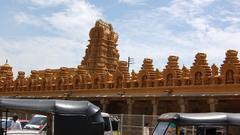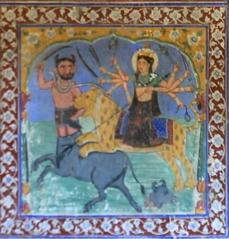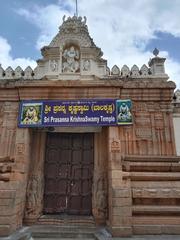
St. Philomena’s Church Mysore: Visiting Hours, Tickets, and Historical Significance
Date: 03/07/2025
Introduction
St. Philomena’s Church in Mysore is a landmark that seamlessly combines captivating neo-Gothic architecture, deep-rooted history, and spiritual significance. Established initially in 1843 to serve the city’s growing Catholic community, the present grand structure was built between 1933 and 1941, inspired by relics of the revered saint and guided by the patronage of Maharaja Krishnarajendra Wodeyar IV. Its iconic twin spires, soaring to 175 feet and inspired by the Cologne and St. Patrick’s Cathedrals, stand as a testament to Mysore’s cosmopolitan heritage and religious harmony.
This comprehensive guide covers everything visitors need to know: from visiting hours and ticket policies to architectural highlights, accessibility, and practical tips. Whether you are a pilgrim, architecture enthusiast, or a traveler exploring Mysore’s historical sites, St. Philomena’s Church is a must-visit destination that offers serenity, rich craftsmanship, and a welcoming atmosphere.
For more detailed insights, see:
Karnataka.com, TravelSetu, Isharethese.com.
Historical Background
Early Origins and Expansion
The origins of St. Philomena’s Church date back to 1843, built to serve Mysore’s expanding European and local Catholic populations. The original church, constructed under the patronage of King Mummadi Krishnaraja Wodeyar, quickly became too small for the growing congregation, prompting the need for a larger structure (Karnataka.com).
Acquisition of the Relic and Royal Support
A significant turning point came in 1926, when a relic of St. Philomena was obtained from Peter Pisani, the Apostolic Delegate of the East Indies. With the support of T.R.V. Thamboo Chetty, Diwan and Chief Justice, and the enthusiastic patronage of Maharaja Sri Krishnarajendra Wodeyar IV, plans for a new church were set in motion. The Maharaja laid the foundation stone in 1933, marking the start of a project that would unite royal, clerical, and community efforts (Karnataka.com; IndiaTravelBlog.com).
Construction and Community Involvement
The construction spanned eight years (1933–1941), funded through generous donations from across India and abroad. Miraculous stories surrounding the construction, such as the timely arrival of funds and accounts of cures, became part of the church’s lore and spiritual appeal (IndiaTravelBlog.com).
Dedication and Relic Preservation
Consecrated in 1941, the church became a major center of Catholic worship in South India. The relic of St. Philomena was enshrined in a crypt beneath the main altar, accessible to pilgrims and visitors to this day (Karnataka.com).
Architectural Grandeur
Neo-Gothic Design and European Influences
French architect Daly designed the church, drawing inspiration from the Cologne Cathedral in Germany and St. Patrick’s Cathedral in New York. The neo-Gothic style, characterized by pointed arches, ribbed vaults, and flying buttresses, gives the structure its awe-inspiring presence (Karnataka.com; TravelSetu).
Structural Layout and Ornamentation
The cruciform (cross-shaped) layout features a long nave, transepts, and a choir area. The twin spires, each 175 feet tall, are visible from miles away and are topped with 12-foot-high crosses. The facade boasts elaborate stone carvings, pointed arches, and flying buttresses for both support and decoration. Locally sourced materials were combined with imported stone and marble for durability and beauty (Agoda; East Indian Traveller).
Stained Glass and Interior Artistry
Inside, vibrant stained glass windows depict scenes from the life of Christ, such as the Nativity and Resurrection. The rose window above the altar and intricately painted frescoes add to the church’s visual and spiritual richness (Banjaran Foodie).
The Crypt and Relics
Beneath the main altar lies the crypt, housing a statue and relic of St. Philomena. This sacred space is open to pilgrims and is adorned with inscriptions and devotional art (TravelSetu).
Cultural and Religious Significance
St. Philomena’s Church is a prominent symbol of Mysore’s pluralistic heritage and religious harmony. As the cathedral for the Diocese of Mysore, it is a vibrant center for worship, hosting regular Masses, festive celebrations, and charity events. The church’s festivals—especially the Feast of St. Philomena on August 11—attract devotees from across faiths and backgrounds, reinforcing its role as a unifying landmark (isharethese.com).
Its architectural blend of Indian and European elements, along with its dedication to a young female martyr, make it a symbol of faith, resilience, and Mysore’s cosmopolitan vision.
Practical Visitor Information
Location and Accessibility
- Address: Lashkar Mohalla, Ashoka Road, Veerangere, Mysuru, Karnataka 570001
- Distance: About 2 km from Mysore Palace, 3 km from the City Bus Stand, and 2.1 km from Mysuru Junction Railway Station (mysoretourism.org.in, thrillophilia.com)
- Transport: Easily accessible by taxi, auto-rickshaw, city bus, or on foot from nearby accommodations.
- Parking: On-site parking is available for a nominal fee (eindiatourism.in).
Visiting Hours and Entry
- Open Daily: Typically from 5:00 AM to 6:00 PM (some sources mention up to 8:30 PM; verify during festivals or special events) (visitplacesindia.com).
- Entry Fee: Free for all visitors.
- Mass Timings:
- Weekdays: 5:00 AM–9:00 AM (morning), 6:00 PM–6:30 PM (evening)
- Sundays: 5:00 AM–6:00 AM, 6:00 AM–7:00 AM, 6:00 PM–6:30 PM
- Special Masses: On Sundays and during annual festivals, notably August 11 (traveltriangle.com)
Accessibility for Differently-Abled
The church is wheelchair accessible at the main entrance, with ramps and designated seating. Assistance is available, and restrooms accommodate mobility needs. Note: Some areas, such as the crypt, may have steps.
Guided Tours
Official guided tours are not regularly scheduled, but local guides and city tours often include the church. Audio guides may be available on request (TravelSetu).
What to See and Do
Architectural and Artistic Highlights
- Twin Spires: 175 feet tall, a signature of the Mysore skyline.
- Stained Glass Windows: Depicting Christian themes and events.
- Main Altar and Crypt: Houses the statue and relic of St. Philomena.
- Rose Window: Above the altar, a stunning piece of religious art.
Spiritual Experience
- Attend mass in multiple languages.
- Light candles at the grotto of Mother Mary.
- Reflect in the adoration chapel or crypt.
- Experience the church illuminated during evening hours and festivals.
Museum and Events
A small museum displays Christian art and artifacts, and the church hosts major celebrations, especially on St. Philomena’s feast day.
Visitor Etiquette and Facilities
- Dress Code: Modest clothing covering shoulders and knees.
- Silence: Maintain quiet, especially during services.
- Photography: Allowed outside and in designated areas. Avoid flash and tripod use inside; photography during services is restricted.
- Facilities: Restrooms, parking, a pilgrim centre (with rooms and halls by advance booking), souvenir shops, and accessible entrances.
Nearby Attractions
- Mysore Palace: 2 km
- Jaganmohan Palace and Art Gallery: 2.5 km
- Chamundeshwari Temple (Chamundi Hill): 13 km
- Mysore Zoo: 3 km
- Brindavan Gardens: 20 km
Tips for Visitors
- Best Time to Visit: October to February for pleasant weather; early mornings for peaceful ambiance.
- Combine with City Tour: The central location makes the church an ideal stop on a Mysore sightseeing itinerary.
- Check Event Schedules: Festivals may affect timings and crowd levels.
- Respect Local Customs: Remove hats, keep silence, and avoid public displays of affection inside the church.
Frequently Asked Questions (FAQ)
Q: What are the visiting hours of St. Philomena’s Church?
A: Open daily, generally from 5:00 AM to 6:00 PM (may extend to 8:30 PM; check ahead for festival schedules).
Q: Is entry free?
A: Yes, entry to the church and museum is free for all.
Q: Are guided tours available?
A: There are no regular guided tours, but local guides can be hired or included in city tours.
Q: Is the church accessible for differently-abled visitors?
A: Yes, the main entrance is wheelchair accessible, and assistance is available.
Q: Is photography allowed inside?
A: Photography is allowed outside and in some interior areas, but flash and tripods should be avoided; respect service times.
Q: What is the best time to visit?
A: October to February is ideal for weather and festivals; mornings are quieter.
Summary
St. Philomena’s Church is an essential stop for anyone visiting Mysore, offering a unique combination of stunning architecture, historical depth, and spiritual tranquility. Free entry, robust accessibility, and its proximity to other historical sites make it an ideal addition to your itinerary. Early morning or festival visits provide the most memorable experiences, and with practical amenities and a welcoming environment, St. Philomena’s Church continues to embody Mysore’s heritage of religious harmony and artistic excellence.
For the latest updates, events, and travel tips, consult the official church website and local tourism resources.
References and Further Reading
- St. Philomena’s Church Mysore: Visiting Hours, Tickets & Historical Significance, Karnataka.com
- St. Philomena’s Church Mysore: Architectural Marvel & Visitor’s Guide, TravelSetu
- St. Philomena’s Church Mysore: Visiting Hours, Tickets, History & Cultural Significance, Isharethese.com
- St. Philomena’s Church Mysore Visiting Hours, Tickets, and Travel Guide, Mysore Tourism Official






